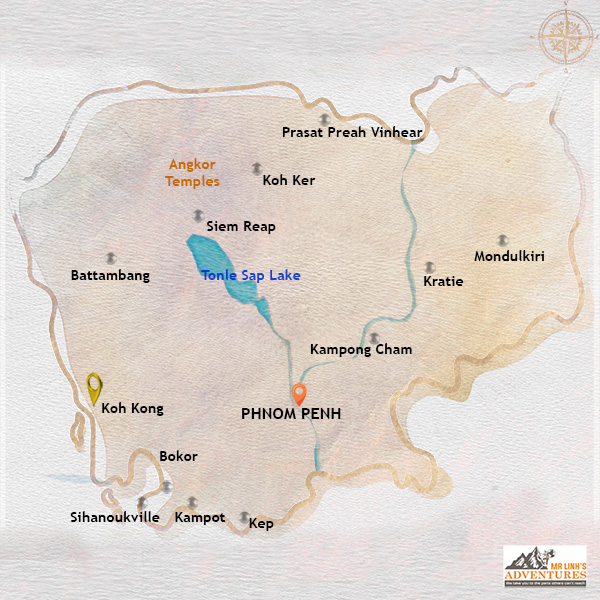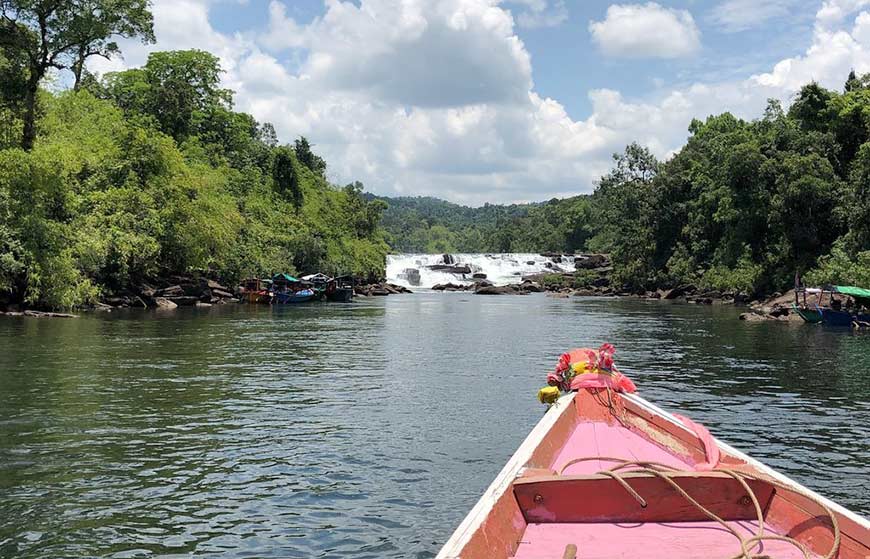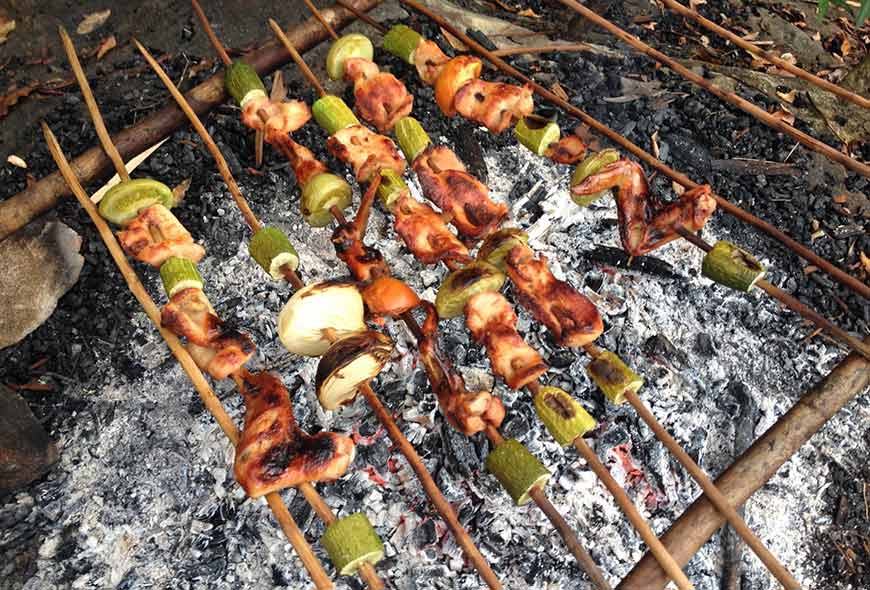 Overview
Overview

Nestled in southwestern Cambodia, the
Koh Kong conservation corridor is a vast and untamed sanctuary of wild nature, offering an unparalleled experience for adventurers and nature enthusiasts. This expansive region is a significant part of the Cardamom Mountains, one of Southeast Asia's most important and biodiverse rainforests.
For the adventurous spirit, Koh Kong is an ideal playground. Days can be spent hiking or biking deep into the jungle, exploring hidden trails, discovering cascading waterfalls, and encountering the region's rich flora and fauna. Beyond trekking and cycling, the area offers a range of adrenaline-filled activities, from kayaking through mangrove channels to embarking on wildlife spotting expeditions.
Whether you're seeking a challenging trek to a mountain summit, an immersive jungle experience, or thrilling encounters with nature, Koh Kong promises an unforgettable adventure in one of Cambodia's most pristine and captivating regions.
 Top Attractions
Top Attractions
 Cambodia's largest island, Koh Kong, is a true paradise
Cambodia's largest island, Koh Kong, is a true paradise
Koh Kong stands out as an ideal destination for travelers yearning for authentic nature, adventure, and tranquility, a welcome escape from the throngs of Cambodia's more frequented islands. This province is a treasure trove of natural wonders, offering experiences that connect you deeply with its pristine environment.
Don't miss these must-see attractions within Koh Kong province:
Koh Kong Island
As Cambodia's largest island, Koh Kong Island remains largely wild and untouched by mass tourism. The island boasts seven stunning beaches along its western shore. Many are fringed by coconut palms and lush foliage, and at the mouth of one small stream you’ll discover a hidden lagoon. On the east side, six forested hills rise from the landscape. It's an unparalleled spot for diving, boasting unspoiled seabeds teeming with marine life. Beyond its underwater allure, you can discover pristine beaches perfect for relaxation and embark on invigorating hikes through the lush rainforest.
The island can only be reached between October and May. From June through September, the rainy season brings strong southwesterly onshore winds that render access impossible.
Tatai Falls
Experience the breathtaking Tatai Falls, a spectacular waterfall nestled on the Tatai River. Accessible by either a scenic kayak trip or a rewarding hike, these falls are situated in the heart of the verdant Cardamom region, offering a serene and picturesque setting.
Cardamom Forest
Delve into the immense Cardamom Forest, a vast mountainous and forested expanse that represents one of the last great rainforests in Southeast Asia. This region is a paradise for ecotourism, hiking, and wildlife watching, providing a unique opportunity to observe diverse flora and fauna in their natural habitat.
 The Peam Krasop Mangove and its vibrant biodiversity
The Peam Krasop Mangove and its vibrant biodiversityMangroves and Coastal Ecosystems
The province is renowned for its rich mangroves and estuaries, which are vibrant with biodiversity. Notably found within Botum Sakor National Park and along its coastal areas, these ecosystems offer a range of activities such as sailing, birdwatching, and experiencing local life in harmony with nature.
 See and Do
See and Do
 Kayak on the Tatai River to the waterfall of the same name
Kayak on the Tatai River to the waterfall of the same name
Koh Kong offers a range of activities for all tastes. Adventurers can dive into jungle trekking, climbing, mountain biking, or rafting. Those seeking relaxation can enjoy serene natural spots and unwind in hammocks. Culture enthusiasts can visit local markets and fishing villages.
Koh Kong City serves as an ideal base, known for river excursions where you might even spot rare Irrawaddy dolphins. It's also the gateway to offshore gems like Koh Kong Island, accessible via guided tours, revealing pristine beaches, hidden lagoons, and a quaint fishing village.
Near the city, Peam Krasop Sanctuary offers a unique immersion into the mangrove ecosystem via an elevated walkway.
The vast Cardamom Mountains are a biodiversity hotspot, home to a significant elephant population and elusive big cats. Exploring this wild range often requires an experienced local guide. The village of Chi Phat offers multi-day eco-excursions, and the Wildlife Release Station of the Wildlife Alliance provides insights into conservation efforts.
The Tatai River, deep within the Cardamom Mountains, invites visitors for tranquil boat trips, kayaking, and stays in charming eco-accommodations near its spectacular waterfall.
Botum Sakor National Park, a critical part of the Koh Kong corridor, promises exceptional wildlife encounters (elephants, pangolins, gibbons) across diverse landscapes, explorable by boat, motorcycle, or 4x4
 Go Green
Go Green
Mr Linh's Adventures offers tailor-made tours in Koh Kong, suitable for all levels and preferences. Whether you're with family, as a couple, or with friends, you'll find the adventure that suits you. The tours include a variety of activities such as hiking, kayaking, fishing, temple visits, and interactions with local communities.
 Heritage
Heritage
 Chi Phat, an eco-tourism community set up by local residents
Chi Phat, an eco-tourism community set up by local residents
One of the best ways to discover local culture is by connecting with communities within the Koh Kong conservation corridor.
Indigenous communities
Engaging with indigenous communities, particularly in areas like the Cardamom Mountains, offers profound cultural insight. In Chi Phat, homestays provide opportunities to learn about their traditions, including unique practices related to funeral jars and wooden coffins. These interactions directly support community-based ecotourism initiatives.
Traditional villages
On the Tatai River, Koh Andet Island offers an authentic experience. Inhabited by a small number of families, visitors can share convivial moments and taste freshly picked coconuts, glimpsing their traditional riverine lifestyle.
Sustainable tourism
At Trapeang Rung, you can participate in local fishing trips and stay with families, directly contributing to environmental protection efforts and gaining a deeper understanding of their sustainable practices.
 Food & Drinks
Food & Drinks
 Khmer BBQ, a must-try in Koh Kong !
Khmer BBQ, a must-try in Koh Kong !
Despite less intensive agriculture, the Cardamom Mountains offer a glimpse into the local cardamom culture, an iconic spice. Taste local dishes made with cardamom and discover the flavors of black, white, and red peppers, also grown in the region.
The Koh Kong region is not limited to its spices. It's teeming with diverse cultures, including exotic fruits such as durian and jackfruit, which are particularly popular among locals. Don't miss the opportunity to taste these fresh fruits, whether at a vibrant market or in a typical restaurant.
Visitors to Botum Sakor National Park and surrounding ecological sites will be pleasantly surprised by the quality of meals offered at the Chi Phat visitor center. The menu, renewed daily, highlights traditional Cambodian cuisine, prepared with local ingredients. Packed lunches are also available for day trips.
 Directions
Directions
Location
Situated in southwestern Cambodia, Koh Kong is a secluded, unspoiled province bordered by Thailand to the west and the Gulf of Thailand to the south.
Koh Kong is located approximately 300 km from Phnom Penh and 400 km from Bangkok.
How to get there
You can reach it by bus, taxi, or boat. Bus ticket prices vary depending on companies and routes, but on average, expect to pay between 10 and 20 USD for a Phnom Penh-Koh Kong trip.
Best time to visit
The best time to visit Koh Kong is from November to April, during the dry season.